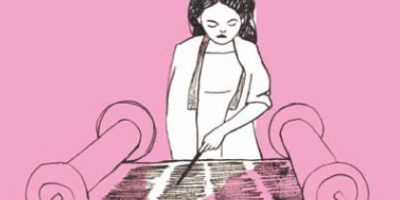
Our Quinseptikons
On the final night of the First American Birth Control Conference in New York City, in 1921, Margaret Sanger arrived at Town Hall in Manhattan with the two speakers who would round out the congress, a Broadway actress and a British Parliamentarian. The reproductive rights pioneer found the New York City police already there, blocking the doors. Some 200 audience members had already taken their seats inside the hall, but Sanger was locked out, and they were now shut in. Among those stuck inside were my great-grandparents, Louis and Francine Weiner.
Louis and Francine were bootleg contraception makers—outlaws at a time when birth control was considered both immoral and illegal. Louis went to work as a pharmacist during the day, but in the evening he and Fanny took to their kitchen, where they spent hours adding quinine to cocoa butter and molding suppositories by hand. They would lay each one, end-to-end, into boxes of 12, which they sent for $1 through the mail. They called them Quinseptikons.
The making of the suppositories wasn’t technically illegal, but providing any information, such as how to use the products, or sending them to consumers, was prohibited by an 1873 federal law known as the Comstock Act. Named after puritan Christian crusader Anthony Comstock, this “chastity” statute defined contraceptives as obscene and illicit, making it a federal offense to disseminate birth control through the U.S. mail or across state lines. The law was so admired that it was copied by twenty-four states, each enacting its own iteration.
New York State’s “anti-vice” law was the ostensible reason for the police to block Sanger’s entry into Town Hall on November 13, 1921. Merely discussing contraception in a public forum was considered criminal behavior. Women’s rights crusader Emma Goldman was arrested a number of times for lecturing and distributing materials about birth control. Sanger’s first husband, William Sanger, was convicted of a crime for distributing a newsletter containing information about contraception. And when Sanger, her younger sister, Ethel Byrne, and a handful of nurses had opened a birth control clinic in 1918, they’d all been arrested, and Sanger and Byrne were sent to prison.
My great-grandfather, Louis, started a correspondence with Sanger in 1918— shortly after she was released from Queens County Penitentiary. The letter, dated September 18, 1918, was about Quinseptikons. She had apparently sent him a (now-lost) letter inquiring about his products, and he replied that they “contain a soluble quinine salt” as well as Zinc Phenol Sulphonate, and “a non-irritating vegetable acid.” He’d included a complimentary sample in the box, he wrote, and signed off: “We thank you for the interest you have shown in our preparations, and hope to be able to serve you in the near future.”
NINA SIEGAL, Lilith Online, December 2023.
Subscribe at Lilith.org • LILITH 7






